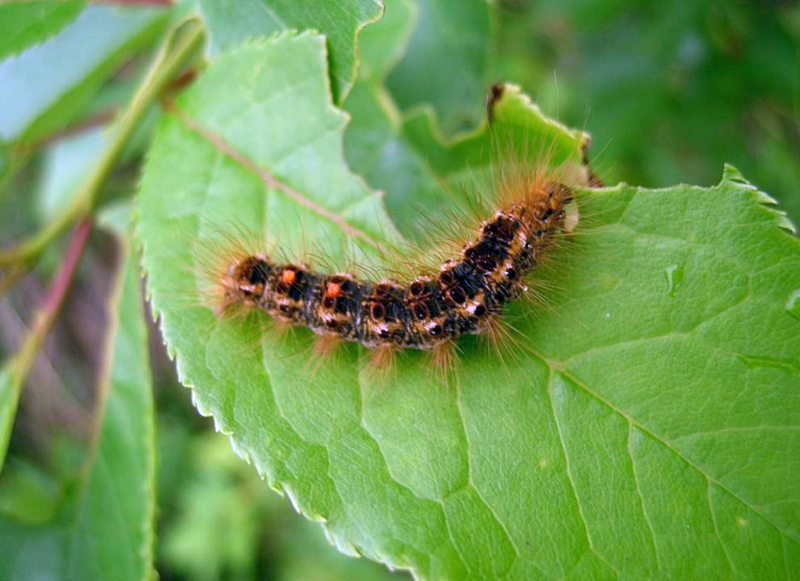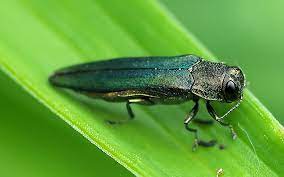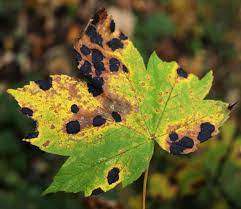SCORES & OUTDOORS: Maine Forest Service updates information on invasive species
Browntail moth caterpillars can be identified by the two distinctive orange dots at the tail end and white tufts along the sides.
by Roland D. Hallee
The Maine Forest Service recently published its last planned bulletin of the season. It was quite lengthy so I have sorted out what I thought would be of interest to our readers. The following are excerpts from that bulletin:
Browntail Moth
This year we saw continued growth in the outbreak of browntail moth (BTM). Call activity was very high, with well over 500 BTM calls and a similar amount of emails received by the Maine Forest Service (MFS) from mid-May to August. This was in addition to calls fielded by 211 (287 calls) and other agencies such as Maine Center for Disease Control (CDC), Maine Board of Pesticide Control (BPC) and Cooperative Extension.
When warranted, we fly two rounds of aerial survey for BTM each year: one in late spring/early summer to pick up defoliation from the mature caterpillars and another in late summer/early fall to capture the skeletonization damage from the newly-hatched caterpillars. The spring survey revealed 172,870.5 acres of defoliation while the fall surveys produced an additional 26,849.5 acres. This brings the grand total for 2021 to 199,720 acres.
In the winter of 2021, field staff detected webs in Aroostook County (Fort Fairfield, Monticello and Smyrna) for the first time since the early 1900’s outbreak. This speaks to the ability of this species to hitch-hike rides on vehicles as the caterpillars, pupae and adults will all take a free ride when they get the chance.
By the second week of April, BTM caterpillars had emerged from their winter webs in Southern Maine to feed on the buds and newly-emerging leaves of host trees. By the second week of May, many of the monitoring sites had fourth instar caterpillars, which are distinguished by their white tufts on each body segment. This was two weeks earlier than in previous years. One explanation for this is that the mild, early spring may have coaxed the caterpillars to emerge and therefore begin feeding earlier. There was quite a bit of variability in size even within a single nest with some caterpillars being as large as three-quarters of an inch while others that were one-fourth of an inch looked as if they had not molted since they emerged in April.
During the second week of May, we began receiving reports of wandering caterpillars, which usually doesn’t occur until the end of May. This might be explained by caterpillars stripping the host plants they emerged on and their need to find better quality food. During the second week of June MFS staff made observations of the first caterpillars pupating at all our monitoring sites. Again, this was a couple of weeks earlier than has been seen in the past (June 26, 2020). Beginning the week of June 27, we began observing emergence of the adult BTM. During the period of adult activity, we received many photos as well as witnessed firsthand the sheer number of adult moths that were attracted to gas station lights as well as any other bright outdoor light. In many areas it looked as is if it had snowed around the lights. We began seeing the first egg masses hatch during the week of August 1, and by the third week of August we observed caterpillars starting to create the web in which they will spend the winter. In late August, we began observing feeding damage from young BTM caterpillars becoming very apparent in many areas, especially in Kennebec County.
As a silver lining to the season, in spite of another year of drought, we observed a few very small and isolated pockets of a BTM-pathogenic fungus and what looks to be the baculovirus associated with BTM in Belfast, Liberty, Jefferson, Blue Hill, Readfield and Dresden; they are likely found in many places in between. What this tells us is that the fungus and virus are very widespread, but in order for these pathogens to spread more and make a significant impact on populations we really need wet weather in May and June. In collecting some of the diseased caterpillars at our monitoring sites for use in future assisted disease dispersal work, we found both parasitoid wasp larvae as well as some fly puparia within the collecting containers. Using the collections of infected caterpillars, we performed some assisted disease dispersal inoculations in Old Town as well as Little Deer Isle since these locations are on the approximate leading edge and these BTM populations did not show signs of infections.
One observation of note in September was a few webs that have deceased browntail moth caterpillars on the outside of the web. It seems to us that this may be due to a pathogen, although we can’t say for sure. Symptomatic caterpillars were fairly widespread on the state office complex in Augusta with most trees that were inspected having at least some webs with deceased caterpillars on them. During this visual inspection we also noticed some flies in the investigating the webs. The larvae of this family of flies are exclusively parasitic on arthropods of all shapes and sizes. There are a few species of tachinid fly that use browntail caterpillars as a host- good news for us and the flies.
Emerald Ash Borer
Emerald ash borer
In October many of the ash trees girdled in the spring were peeled and inspected for signs of emerald ash borer (EAB). Over 50 trees were girdled in the spring by the Maine Forest Service and cooperators. This year we had wonderful participation by private landowners, which helped us monitor for EAB more widely throughout the state. Well over half of the trees have been peeled, and we have found EAB in two of them. In Frenchville (Aroostook County), we found EAB in a girdled tree at a site we hope to use for future biological control. This is the second time we have found EAB in Frenchville. In Cumberland County, we found EAB for the first time in the town of Falmouth, also at a potential biological control release site.
The remaining girdled trap trees will be processed over the coming weeks. If you have a girdled tree on your property and have not yet made arrangements with us for peeling, please contact us at foresthealth@maine.gov.
Out-of-State Firewood Concerns
October was a busy month in terms of out-of-state firewood inspections, with two situations of high concern brought to our attention. The first involved the voluntary surrender of a load of firewood brought to Maine from Vermont by a visitor unaware of the out-of-state firewood ban. The wood was collected by a forest ranger and transferred over to the Insect and Disease lab for inspection. We credit this positive outcome to additional new signage on the border emphasizing that all out-of-state firewood is banned from entering Maine. The only exception to this rule is firewood that has been certified heat-treated, in which case it must be accompanied by documentation indicating it has been heat-treated to Maine’s required standard.
Tar Spot
Tar spots
There are several species of fungi in the genus Rhytisma that produce a tar spot symptom on our several types of trees and shrubs in Maine. Tar spot on Norway maple is caused by a non-native fungus (R. acerinum), and it is especially prevalent in several parts of Maine this year, as in most years. The also non-native (and currently considered invasive) Norway maples, including cultivars of Norway maple in horticultural settings, such as the burgundy-leaved Crimson King maple, are particularly susceptible to tar spot. Tar spots on our native maples are caused by native Rhytisma. They are encountered less frequently and typically cause only minor damage.
The fungi that cause tar spot survive the winter in fallen leaves and produce and disseminate spores during prolonged periods of wet weather in spring. Thus, collecting and disposing leaves is the recommended management strategy. If composting the collected leaves on-site, the leaf piles should be covered with a layer of soil, a dense layer of grass clippings or other compost. This will prevent the fungus from dispersing spores to re-infect maples the following spring. Leaves can also be burned when and where this is permitted. Chemical management of tar spot is rarely required or practical since these diseases primarily represent an aesthetic issue and have little detrimental effect on the long-term health of affected trees and shrubs.
Roland’s trivia question of the week:
Who was the New England Patriots’ starting quarterback in their first Super Bowl appearance in 1985?
Responsible journalism is hard work!
It is also expensive!
If you enjoy reading The Town Line and the good news we bring you each week, would you consider a donation to help us continue the work we’re doing?
The Town Line is a 501(c)(3) nonprofit private foundation, and all donations are tax deductible under the Internal Revenue Service code.
To help, please visit our online donation page or mail a check payable to The Town Line, PO Box 89, South China, ME 04358. Your contribution is appreciated!






Leave a Reply
Want to join the discussion?Feel free to contribute!